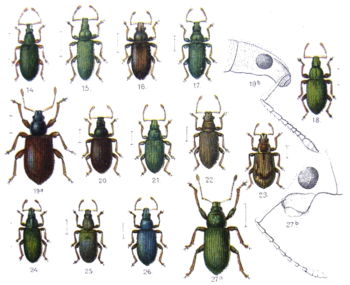Green weevil
The green weevil as an ecological group usually includes weevils under one centimeter long with the following characteristics
- Most species are bright green in color due to their scales
- Their larvae , which gnaw at roots, are potential pests
- The adults gnaw on leaves and are also potential pests
From this point of view, they form a unit for nature lovers, gardeners, fruit and forest farmers as well as producers of insecticides etc. In particular, foresters summarize the species of the genera Phyllobius and Polydrusus (formerly Polydrosus ) under green weevils . Figure 1 shows representatives of these two genera. They agree not only in the three aspects mentioned above, but also in their body structure due to the following characteristics:
- The broad, short trunk makes the head appear rectangular when viewed from above, the pronotum is only slightly wider and bell-shaped, the elytra, on the other hand, are about twice as wide and with their pronounced shoulders are clearly separated from the pronotum. The label between the base of the wing covers is clearly visible and triangular. The wing covers widen slightly backwards to the last third and then converge almost in a straight line to a point.
- The two pairs of jaws are exposed. The antennae are remarkably long and thin, the first antennae (the shaft) reaches at least the front edge of the eyes, the angled hostage consists of seven clearly visible members and the final club consists of four members. The eyes are round and lateral.
- The legs are strong, the claws grown together at the base. The fore legs are slightly bent inwards, and there is usually a clearly visible thorn on the inside.
The major systematic difference lies in the shape of the feeler pit. The feeler pit is the recess in the trunk into which the feeler is pivoted. So that the beetles can place the feelers on the body to protect them, the feeler pit often ends in a groove in which the stem of the feeler comes to rest. In Phyllobius this groove is only indicated by a bulge of the antennae on the upper side of the trunk (Fig. 1, Fig. 19b and Fig. 2), in Poydrusus it runs clearly on the side of the trunk towards under the eyes (Fig. 1, Fig. 27b and Fig. 3). Therefore Phyllobius and Polydrusus not only form different genera, but they even belong to different subfamilies of the weevils .
Other green weevil species are characterized by the fact that the wing covers do not protrude through a shoulder, but are rounded, the label is not clearly triangular or other characteristics listed above do not apply. It should be noted that the flood of photos of green weevils shown on the web are often insufficient and often incorrectly determined.
literature
- Jiři Zahradník, Irmgard Jung, Dieter Jung et al .: Käfer Central and Northwestern Europe , Parey Berlin 1985, ISBN 3-490-27118-1
- H. Joy, KW Harde, GA Lohse, B. Klausnitzer (Hrsg.): The beetles of Central Europe. 15 vols., Elsevier 1965-2004. ISBN 3-8274-0674-9
Web links
- Fauna Europaea: Phyllobius Germar 1824 Taxonomy (English)
- Fauna Europaea: Polydrusus Germar 1817 Taxonomy (English)


